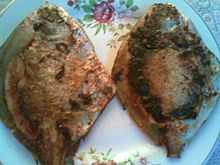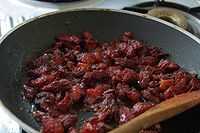Goan Catholic cuisine


The Goan Catholic Cuisine is the cuisine of the Goan Catholic community and is largely influenced by the Saraswat, Konkani, Portuguese, South Indian, and British cuisines.[1]
Goan Catholics are Roman Catholics from the state of Goa, a region on the west coast of India. Most of the Goan Catholics, are descended from Saraswat Brahmins, Kshatriya, and Vaishya natives of Goa. The rest of the locals of Goa who were converted to Christianity during the Portuguese rule. Their culture is a blend of Indian and Portuguese cultures.
Non-vegetarian

Goan Catholic cuisine has distinct Portuguese influence as can be seen in the Roast Maas, the famous pork roast crackling served as the Pièce de résistance at wedding dinners, or the Pork Sorpotel with slight variations, Cabidela, where fresh blood is stirred into the pork delicacy. The Mainstay of the Ros[a] dinner is Pork Bafad. Their curries use a lot of coconut, coconut oil, and spices along with vinegar. Xit Kodi (Xit – par-boiled or red rice; Kodi – fish curry) forms the staple food of the community. Other popular Portuguese influenced delicacies are Chouriço (pork sausage), Vindaloo, Fish Rechad, and Xacuti.[2]
Chamuças is a Goan derivative of samosa, which usually is filled with beef or pork and is a well-known snack.[1] Croquettes, beef cutlets, and beef potato chops are common snacks. Roast beef and beef tongue are popular entrees at Goan celebrations. The traditional, Mol De Peixe (Fish pickle) and Balchão (prawn pickle sauce, are originally from Macau).
Vegetarian
.jpg)
Patoleo, a dish of turmeric leaves stuffed with rice, dal, jaggery, and coconut is mainly prepared on the feast of the Assumption of the Blessed Virgin Mary, especially by the Goan Catholics settled in Mumbai. The Pez (a type of Congee), Koiloris and Podecho (variants of dosa), and Sanna (a variant of idli) are a popular delicacy made of soaked rice, water, and salt.
Sweets such as Guava cheese (perad), Kadio bodio (tiny stick made of Maida flour dipped in sugar syrup and dried), are well-known.[3] The Cashewnut laddus, Khaje, Revdyo, Peda, Tizan, Godshem, Puran Poli, and Sakhar Bhat are well-known sweet dishes. Filoz (a jaggery and banana pancake), and Arroz doce (rice pudding) a Portuguese derivative of kheer (sweetened rice) of India also is popular.
The feni: cashew feni is made from the fermentation of the fruit of the cashew tree, while coconut feni, made from the sap of toddy palms, is popular alcoholic beverage.[4]
Kuswar is a term often used to refer to a set of unique Christmas goodies that are part of the cuisine of the Goan Catholic community. There are as many as 22 different traditional recipes that form this distinct flavour of Christmas celebration in Goa. Neuries are mince puffs stuffed with plums, nuts, and fried theel and sugar. Kidyo or Kulkuls are curly concoctions dipped in sugar treacle, bolinhas are small cakes also known as coconut cookies, perad are savoury of guavas, Nankatais resembling snow balls are made from a batter of sugar, butter, and flour, Baath is a moist rich coconut tart baked in a large round shape with pastry lattice work on top, Marzipan a confection consisting primarily of sugar and cashew or almond meal, and Doce is a sweet made using chickpeas and coconut.
Bebinca, a rich egg-based multi-layered sweet dish, is what Goa is famous for and the subtle flavoured rose cookies are a hot favourite, but it is the Rich Plum Cake which takes the better part of a week to make that is the most famous. Candied fruit, plums, currents, and raisins are dexterously cut and soaked in rum. Flour is sieved and gently warmed in the sun. Nuts are pealed and chopped and the whole family comes together to make the cake. Jobs are allotted, one to whip up the eggs, while another creams the butter and sugar, cake tins are lined, and a strong pair of arms requisitioned to do the final mixing and stirring.
Notes
^ Ros is a ceremony celebrating the last day of the virginity of a bride and bridegroom. The bride is massaged with coconut milk.
Citations
- ↑ 1.0 1.1 Sen 2004, p. 105
- ↑ "Goa Delights". The Hindu. Retrieved 2008-10-26.
- ↑ Shradha Sukumaran (2008-09-09). "Bandra fair lays out a sweet spread". Indian Express Newspapers (Mumbai) Ltd. Retrieved 2008-09-27.
- ↑ Sulekha Nair (Jan 18, 2009). "Goan delight". The Financial Express Newspapers Mumbai Ltd. (Express Group). Retrieved 2009-03-02.
References
- Sen, Colleen Taylor (2004). Food Culture in India. Greenwood Publishing Group. ISBN 0-313-32487-5. Retrieved 2008-08-29.